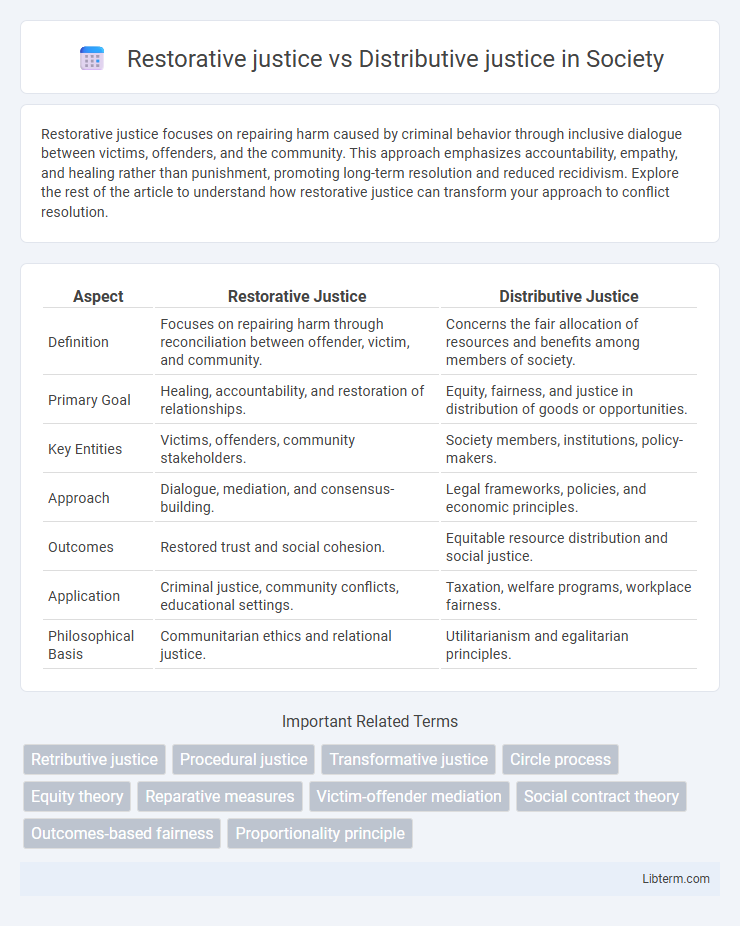Restorative justice focuses on repairing harm caused by criminal behavior through inclusive dialogue between victims, offenders, and the community. This approach emphasizes accountability, empathy, and healing rather than punishment, promoting long-term resolution and reduced recidivism. Explore the rest of the article to understand how restorative justice can transform your approach to conflict resolution.
Table of Comparison
| Aspect | Restorative Justice | Distributive Justice |
|---|---|---|
| Definition | Focuses on repairing harm through reconciliation between offender, victim, and community. | Concerns the fair allocation of resources and benefits among members of society. |
| Primary Goal | Healing, accountability, and restoration of relationships. | Equity, fairness, and justice in distribution of goods or opportunities. |
| Key Entities | Victims, offenders, community stakeholders. | Society members, institutions, policy-makers. |
| Approach | Dialogue, mediation, and consensus-building. | Legal frameworks, policies, and economic principles. |
| Outcomes | Restored trust and social cohesion. | Equitable resource distribution and social justice. |
| Application | Criminal justice, community conflicts, educational settings. | Taxation, welfare programs, workplace fairness. |
| Philosophical Basis | Communitarian ethics and relational justice. | Utilitarianism and egalitarian principles. |
Introduction to Justice Paradigms
Restorative justice emphasizes repairing harm by fostering dialogue and reconciliation between victims and offenders, aiming to restore relationships and community harmony. Distributive justice focuses on the equitable allocation of resources, rights, and responsibilities, ensuring fairness in societal distribution based on merit, need, or equality principles. These justice paradigms represent distinct approaches to addressing wrongdoing and fairness within legal and social frameworks.
Defining Restorative Justice
Restorative justice is a conflict resolution approach that emphasizes repairing harm caused by criminal behavior through inclusive dialogue between victims, offenders, and the community. Unlike distributive justice, which focuses on the fair allocation of resources and punishment, restorative justice seeks to restore relationships and promote healing. This method prioritizes accountability, empathy, and the reintegration of offenders into society.
Understanding Distributive Justice
Distributive justice emphasizes the equitable allocation of resources, benefits, and burdens among individuals or groups based on principles such as equality, equity, and need. It seeks fairness in outcomes by ensuring that everyone receives their due share according to social, economic, or legal criteria. This form of justice is central to policies addressing wealth distribution, social welfare, and access to opportunities.
Philosophical Foundations of Each Approach
Restorative justice is grounded in relational ethics and emphasizes repairing harm through dialogue, accountability, and community involvement, drawing from communitarian and virtue ethics philosophies. Distributive justice centers on the fair allocation of resources and benefits, rooted in principles of equality, equity, and fairness as discussed by philosophers like John Rawls and Aristotle. The philosophical foundation of restorative justice prioritizes reconciliation and healing, whereas distributive justice focuses on impartiality and justice in social and economic distributions.
Key Objectives and Principles
Restorative justice focuses on repairing harm by involving victims, offenders, and the community to promote healing and restitution. Distributive justice centers on the fair allocation of resources and benefits, emphasizing equality and impartiality in the distribution process. Key principles of restorative justice include accountability, dialogue, and reconciliation, whereas distributive justice prioritizes equity, fairness, and consistency in outcomes.
Processes and Mechanisms
Restorative justice emphasizes dialogue, reconciliation, and repairing harm through mediated meetings between offenders, victims, and community members, fostering mutual understanding and accountability. Distributive justice centers on the equitable allocation of resources or burdens based on fairness principles, often enforced through legal frameworks and institutional decision-making processes. Restorative mechanisms involve collaborative problem-solving and emotional restoration, whereas distributive mechanisms rely on policy implementation, standardized rules, and adjudication to address justice concerns.
Roles of Stakeholders
Restorative justice involves active participation of victims, offenders, and community members in dialogue and agreement to repair harm and restore relationships. Distributive justice primarily assigns responsibilities to policymakers and institutional authorities who ensure fair allocation of resources and opportunities based on equity criteria. In restorative justice, stakeholders collaborate to address emotional and social impacts, while distributive justice emphasizes impartiality and systemic fairness enforced by governing bodies.
Case Studies: Practical Applications
Restorative justice case studies, such as the South African Truth and Reconciliation Commission, emphasize healing and community involvement by addressing victims' and offenders' needs directly. Distributive justice applications are evident in welfare policy reforms and taxation systems designed to allocate resources equitably among populations, as seen in Scandinavian social democracies. These practical examples highlight restorative justice's focus on restoring relationships and distributive justice's emphasis on fairness in resource distribution.
Comparative Advantages and Challenges
Restorative justice emphasizes repairing harm through dialogue and reconciliation, fostering community healing and offender accountability, while distributive justice focuses on equitable allocation of resources and benefits to achieve fairness in societal structures. Restorative justice excels in personalizing justice and reducing recidivism but faces challenges in scalability and consistency across cases. Distributive justice provides a clear framework for fairness in policy and social welfare but may overlook individual experiences and the relational dynamics of justice.
Future Directions and Integrative Possibilities
Future directions in restorative justice emphasize integrating community involvement and victim-offender mediation to complement distributive justice's focus on equitable resource allocation and legal fairness. The potential for an integrative framework lies in combining restorative practices with distributive principles to address both relational harm and systemic inequalities comprehensively. Emerging research supports hybrid models that leverage the strengths of both approaches to enhance social cohesion and justice outcomes.
Restorative justice Infographic

 libterm.com
libterm.com